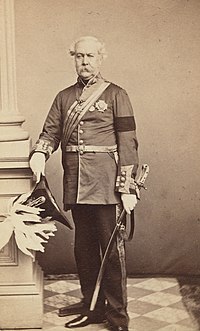
Summary
General Sir Thomas Simson Pratt, KCB (1797 – 2 February 1879) was a British Army officer. He served in the First Anglo-Chinese War (1839–1841), in India from 1843 to 1855 where he was deputy adjutant-general at Madras, and was commander of the British Forces in Australia from 1856 to 1861. He was promoted to lieutenant-general on 31 May 1865, and to full general eight years later.
Sir Thomas Pratt | |
|---|---|
 Pratt as major-general, c. 1864 | |
| Birth name | Thomas Simson Pratt |
| Born | 1797 Kingdom of Ireland[1] |
| Died | 2 February 1879 (aged 82)[2] Bath, Somerset, England |
| Buried | |
| Allegiance | |
| Service/ | |
| Rank | General |
| Campaigns | Napoleonic Wars
|
| Awards | China War Medal (1842) New Zealand War Medal Knight Commander of the Most Honourable Order of the Bath[7] |
He was commander of the British Forces in New Zealand from 1860 to 1861, and was on the Executive Council. He commanded during the First Taranaki War, but as he realised the doubtful validity of the Waitara Purchase (the main cause of the war), he disagreed with Governor Gore Browne, and his military action was ridiculed by the local settlers. He was created KCB for his services in New Zealand by the British Government.
Biography edit
Pratt, born in 1797, was son of Captain James Pratt, by Anne, daughter of William Simson, and was educated at St. Andrews University. He was gazetted to an ensigncy in the 26th (Cameronian) Regiment of Foot on 2 February 1814, and served in Holland in the same year as a volunteer with the 56th (West Essex) Regiment of Foot.
He was present at the attack on Merksem on 2 February and the subsequent bombardment of Antwerp in 1814.[3] He purchased his captaincy on 17 September 1825 and was with the 26th foot in the First Anglo-Chinese War. He commanded the land forces in the Second Battle of Chuenpi on 7 January 1841 and at the Battle of the Bogue on 26 February.[4] In the attacks on Canton from 24 May to 1 June, he was in command of his regiment, and was present also at the demonstration before Nanking, and at the signing of the Treaty of Nanking on board HMS Cornwallis. On 28 August 1841, he was gazetted lieutenant-colonel, and from 5 September 1843 to 23 October 1855 was deputy adjutant-general at Madras. He was made a Companion of the Order of the Bath (CB) on 14 October 1841.
-
The storming of Chuenpi, 7 January 1841. Artist: Lt Frederick J White, RM.
-
Signing and sealing of the Treaty of Nanking, HMS Cornwallis, 29 August 1842. Principal officers and official gentlemen.
-
Key to the painting. No.50. Lt Col Pratt, CB, Cameronians.
From 1856 to 1861, he was in command of the forces in Australasia, based in Melbourne, with the rank of major-general. During 1860–61, he was in New Zealand, conducting the war against the Maori.[4] On his return to Australia he commanded the forces in Victoria until May 1862, and was then appointed to the colonelcy of the 37th (North Hampshire) Regiment of Foot, which he held until his death. He was promoted to Knight Commander of the Most Honourable Order of the Bath (KCB) on 16 July 1861, being publicly invested with the ribbon and badge by Sir Henry Barkly, governor of Victoria, on 15 April 1862, which was the first ceremony of the kind performed in Australia. He was advanced to the rank of general on 26 May 1873.
He died at Bath, Somerset, England, on 2 February 1879[3] after suffering a stroke during the birthday party of a fellow army general, Sam Campbell. He had married Frances Agnes in 1827, second daughter of John S. Cooper. They had seven sons, James Lisson, Thomas Arthur Cooper, Francis Edward, Robert Torrens, Sisson Cooper, Chalmers and William Simson, and a daughter, Anne Maria, who became a botanist in 1860 and she married Sir Henry Barkly, then Governor of Victoria, Australia.[8]
References edit
- ^ 1871 England Census
- ^ "Funeral of General Sir T. S. Pratt". Bath Chronicle. 13 February 1879. p. 7. Retrieved 23 May 2019.
- ^ a b c d e Bromley, Janet; Bromley, David (2015). Wellington's Men Remembered: A Register of Memorials to Soldiers who Fought in the Peninsular War and at Waterloo. Vol. 2 M–Z. Pen and Sword Military. ISBN 9781848847507.
- ^ a b c Hart, H. G. (1864). The New Army and Militia List for 1864. Vol. 25. London: John Murray. p. 295.
- ^ "New Zealand Spectator and Cook's Strait Guardian". Vol. 15, no. 1589. 24 October 1860. p. 2.
- ^ Prickett, Nigel (2016). Fortifications of the New Zealand Wars (PDF). Wellington: Department of Conservation. p. 158. ISBN 9780478150698.
- ^ The Collection of Medals Formed by Bill and Angela Strong (PDF), London: Dix Noonan Web, 18 May 2011, p. 139
- ^ "Lady Barkly, 1863". National Portrait Gallery collection. Retrieved 13 April 2021.
Sources edit
- Biography in the 1966 Encyclopaedia of New Zealand
- Dictionary of New Zealand Biography, Volume 1, 1990
- Australian Dictionary of Biography, Volume 5, 1974
- Attribution
This article incorporates text from a publication now in the public domain: "Pratt, Thomas Simson". Dictionary of National Biography. London: Smith, Elder & Co. 1885–1900.


